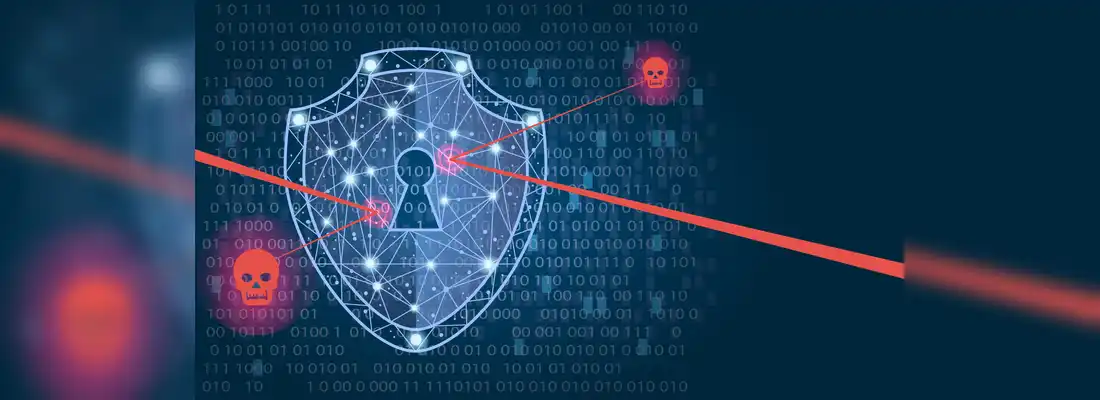Cyber Management in Healthcare: Why You Can’t Rely Only on Internal IT
Date: 20 November 2025

Digital healthcare has opened the door to precise diagnostics, telemedicine, and instant data exchange between doctors. But with this convenience came risk. Every new server, sensor, or cloud storage system becomes a potential entry point for attackers.
Introduction: The New Reality of Medical Security
Medical data is not just numbers. It’s patient histories, test results, personal information. A data leak destroys patient trust and can cost an institution millions.
Many clinics still rely on their in-house IT department as the only line of defence. This is a mistake. IT teams know how to keep systems running, but they’re not built to repel targeted cyber attacks. Modern security demands constant monitoring, threat analysis, and 24/7 response.
Without external support, even a strong internal team becomes overwhelmed. In cyberspace, the adversary never sleeps. Attackers look for weak spots – often finding them where staff simply didn’t have time to install a patch or check a log.
The goal of this article is to show why healthcare requires multilayered protection and collaboration with cybersecurity experts – not just the efforts of an internal IT department.
Why the IT Department Shouldn’t Be the Only Shield
An internal IT department is the backbone of technical support. Its job is to keep systems stable, assist users, and install updates. But data protection is a different discipline. Cybersecurity requires specialised tools, processes, and constant attention to detail.
Modern cyber attacks are not random failures. They’re carefully planned. Attackers study infrastructure, forge accounts, and infiltrate through innocent-looking emails. Detecting them requires specialised analysts, intrusion detection systems, and real-time monitoring – things most internal teams lack.
The IT department’s focus is operational support. Its top priority is uptime, not identifying faint anomalies in traffic. As a result, critical events often go unnoticed until it’s too late.
Healthcare is especially vulnerable. Every connected device – from a diagnostic scanner to a patient registration system – can become an entry point. When systems go down, it’s not just the business that suffers but the patient too. That’s why data protection must be entrusted to those who specialise in it.
Modern clinics increasingly partner with external experts and Managed IT service providers. These companies deliver continuous monitoring, security audits, and infrastructure management following industry standards. One successful example of this approach is described in Svitla Systems for healthcare innovation, where technology support helps medical organisations strengthen system resilience, improve data exchange, and reduce downtime risks.

The Main Risks of Relying Only on the Internal IT Department
Even experienced IT teams face limitations. They lack round-the-clock monitoring, access to global threat intelligence, and time to track new vulnerabilities. The table below shows the typical duties of an internal IT department and what often remains neglected.
|
Responsibility Area |
IT Department Actions |
What’s Often Overlooked |
|
System Management |
Installing updates, configuring servers, fixing issues |
Vulnerability analysis and impact assessment of new threats |
|
User Support |
Handling access and equipment issues |
Detecting suspicious user behavior and phishing attempts |
|
Network & Infrastructure |
Maintaining stable connections, configuring routers |
Real-time traffic monitoring and intrusion detection |
|
Backup Management |
Creating backups, restoring after failures |
Verifying backup integrity, protecting storage from ransomware |
|
Compliance |
Basic access and password policies |
Full audit documentation and security log review |
This table shows that IT departments focus on stability and efficiency, not proactive defence. Cybersecurity requires different tactics – behavioural analytics, threat modelling, and continuous learning.
Without external support, blind spots remain. Zero-day exploits and sophisticated phishing campaigns often go unnoticed until the damage is done. Even a well-organised clinic can face data breaches or operational shutdowns.
The Consequences of Weak Data Protection
When internal teams handle only basic IT support, the organisation lacks critical layers of protection. In healthcare, the consequences are especially severe – a single breach can paralyse operations and harm patients.
According to the European Union Agency for Cybersecurity (ENISA), more than 300 cybersecurity incidents were recorded in the European healthcare sector in 2023. Nearly half targeted hospitals and laboratories. The main causes: outdated systems, poor network segmentation, and human error.
The gap between IT support and true cybersecurity is clear:
- IT departments focus on uptime, not ongoing threat analysis.
- Lack of 24/7 monitoring increases the chance of missing attacks.
- Without external expertise, organizations can’t adapt quickly to new attack methods.
Such gaps make any institution an easy target. A single compromised password or infected email can halt operations and disable vital systems.
The Role of External Partners and Security Providers
Professional Managed Security Service Providers (MSSPs) act as an external shield embedded within the client’s infrastructure. They don’t replace the IT department – they strengthen it. Their mission is to close the gaps the internal team doesn’t even see.
These partners provide continuous monitoring, automated threat detection, and instant response. Unlike in-house teams, they leverage global threat databases and analyze millions of signals in real time – predicting attacks before they reach the network.
One major benefit of collaboration is shared responsibility. The IT department continues to handle operations, while the MSSP manages perimeter defense, incident response, and compliance with standards such as HIPAA or ISO 27001.
In healthcare, this approach is vital. Downtime is unacceptable; even a few minutes can affect patient care. An external partner ensures readiness to react instantly and recover systems without data loss.
They also conduct penetration testing and staff training. This minimises human error – the main cause of most incidents. Regular simulations and crisis exercises make the whole organisation more resilient.
True cyber resilience emerges only through this combination – internal knowledge and external expertise.
Practical Steps to Strengthen Cybersecurity in Healthcare
To turn security from theory into practice, organisations need concrete actions. No plan works without discipline, verification, and clear roles. Below are key steps every healthcare organization should implement.
1. Audit Your Infrastructure
Inventory all devices, servers, clouds, and data channels. Identify where sensitive data resides and who can access it. Without a clear picture, protection is impossible.
2. Implement Network Segmentation
Divide your network into zones: administrative, clinical, and guest. This limits the spread of attacks. If an attacker breaches one zone, they can’t easily move laterally.
3. Strengthen Access Control
Deploy multi-factor authentication, regular password rotation, and automatic lockouts for suspicious activity. Grant access on a strict “need-to-know” basis.
4. Establish Continuous Monitoring
Use SIEM and SOC-as-a-Service tools to analyze events, detect anomalies, and issue alerts automatically. This is the foundation of proactive defense.
5. Conduct Drills and Tests
Regular cyber tabletop exercises and penetration tests expose weaknesses before attackers do. Run these simulations at least twice a year.
6. Educate Your Staff
Every employee should recognize phishing emails and understand why plugging in unknown devices is risky. Awareness is the strongest defense.
7. Engage an External Partner
Even skilled IT teams benefit from external security experts. A fresh perspective helps identify hidden vulnerabilities, streamline response procedures, and keep systems alert.
These steps don’t demand massive investments but build a culture of security. And culture is what separates secure organizations from those that rely on luck.
Conclusion: Security as a Shared Responsibility
Cybersecurity in healthcare isn’t a project or a one-time effort. It’s an ongoing process that requires attention, updates, and participation across all organizational levels.
The in-house IT department remains crucial, but its resources alone aren’t enough to combat evolving threats. Without external expertise, continuous monitoring, and regular audits, “security” becomes an illusion of control.
Healthcare cannot afford to depend on luck. A single incident can disrupt treatment, erode patient trust, and cause reputational damage beyond repair.
Strong cybersecurity is built on partnership – between IT teams, management, technology vendors, and external experts. It’s a shared responsibility, where everyone knows their role and acts in unison.
Only this collaborative model keeps medical organisations resilient in a world where data has become a new form of life – and its protection, a matter of ethics and survival.





-1.webp)
-1.webp)
-1.webp)
